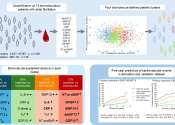Acute coronary syndrome (ACS) is usually one of three diseases involving the coronary arteries: ST elevation myocardial infarction (30%), non ST elevation myocardial infarction (25%), or unstable angina (38%).
These types are named according to the appearance of the electrocardiogram (ECG/EKG) as non-ST segment elevation myocardial infarction (NSTEMI) and ST segment elevation myocardial infarction (STEMI). There can be some variation as to which forms of MI are classified under acute coronary syndrome.
ACS should be distinguished from stable angina, which develops during exertion and resolves at rest. In contrast with stable angina, unstable angina occurs suddenly, often at rest or with minimal exertion, or at lesser degrees of exertion than the individual's previous angina ("crescendo angina"). New onset angina is also considered unstable angina, since it suggests a new problem in a coronary artery.
Though ACS is usually associated with coronary thrombosis, it can also be associated with cocaine use. Cardiac chest pain can also be precipitated by anemia, bradycardias (excessively slow heart rate) or tachycardias (excessively fast heart rate).









